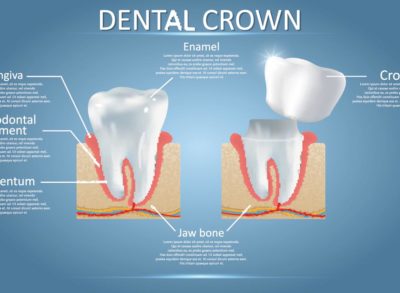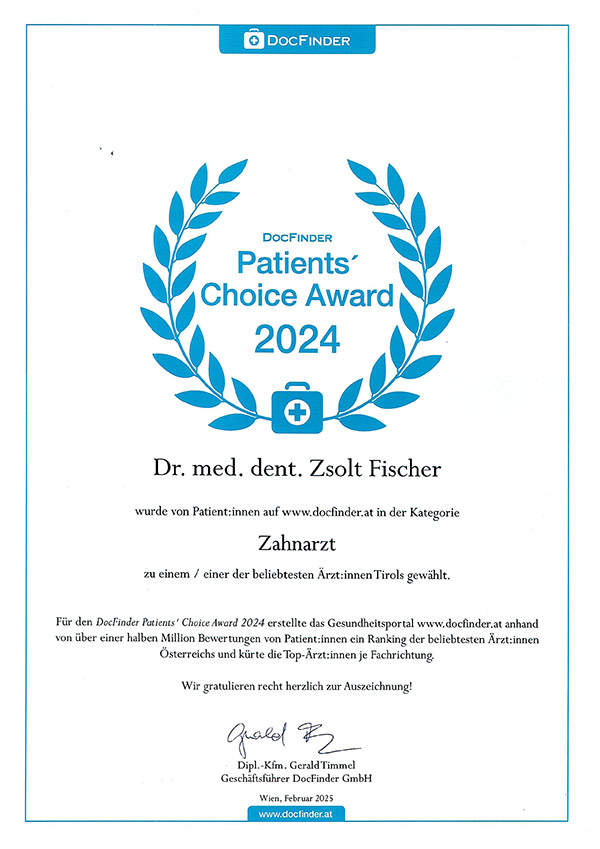Dental Bridges
The treatment with crowns will take place if already a large part of the healthy dental substance is destroyed and cannot functional rebuild by a filling. Initially dental crowns were made from metal – mainly from gold. Thanks to the state-of-the art technologies the metal in crowns could be replaced by ceramics. First, only thin layers of ceramics have been used for the veneering of the metal crown, the share of it successively was increased and nowadays full ceramic crowns will be used. With the naked eye they hardly may be distinguished from a healthy tooth since the passage between tooth and gums is invisible. Unfortunately, with metal ceramic crowns it quite may happen that the passage will be visible with an ugly black edge.
Depending on indication we recommend to you according to your needs and wishes the following crown models:
- Metal ceramic crown with metal core
- Full ceramic crown with pressable ceramics (also porcelain crown or jacket crown)
- Full ceramic crown with Zirconia oxide core
1. Metal Ceramic Crowns
A metal ceramic crown with metal core may be made aesthetically sophisticated and in the posterior tooth area visibly may not be distinguished from the own teeth. Due to the opaque layer applied to the metal these crowns appear as artificial and therefore this type is not so much suitable for the front teeth area. They reflect a great deal of light and therefore seem not natural. In the opposite, after a few years the dark edges will become visible what may be named anything but aesthetic. The ceramic material will be burned up to the crown frame whereby it connects firmly to the metal substrate (steel, gold). In consultation with the patient the colour of the crown will be determined, whereby individual requests may be considered. This type of crown has been manufactured since decades and by and by will be replaced by full ceramic crowns.
Full Ceramic Crowns
Today, compared to the natural tooth, the full ceramic crown provides the optimum of aesthetics and with a good manufacturing at a dental technical lab they hardly may be distinguished from the own teeth.
They are 100 % metal-free, laser measured, and computer milled, by which an optimal edge density and irritation freeness at the gums will be guaranteed. The material is biological neutral, very compatible to the gums and has a lifelike hardness. The interplay with light in the mouth almost is identical with the natural teeth.
Today, we are using more and more full ceramic crowns. The metal ceramic crowns only will be applied to the posterior tooth area. The bio-compatible ceramic as regards to perfectly shaped aesthetics unrivalled. But the manufacturing of a full ceramic crown takes more time and they belong to the top performances of the modern dentistry and dental technology.
As basic material a ceramic mixture is used which in a sophisticated manufacturing process individually can be matched to the natural teeth. For the final insertion colour matching cements will be used to prevent discoloration.
The Advantages of a Full Ceramic Crown
Besides the very good compatibility of the material and, because of the good temperature insulation of the grinded tooth, the reduction of the sensitivity against heat or cold surely the excellent cosmetic result the most essential advantage of a full ceramic crown. The edge covering is perfect, the gums do not “notice” that there are crown edge is in the vicinity and does not withdraw itself over the years – the crown edge, compared to the metal ceramic crown, will be not or only far later visible.
The Disadvantage of a Full Ceramic Crown
The only drawback of the full ceramic crown is the higher price depending on the manufacturing since both the dentist and the dental laboratory must work very precise and sophisticated. This disadvantage will be qualified by the outstanding optic, durability, and compatibility.
2. Full Ceramic Crowns from Pressable Ceramic
If single crowns have to be manufactured. This crown type is the widely used treatment. They consist of several ceramic layers and provide stability both in the posterior teeth area and the front the best optic and gum compatibility. Unfortunately, this ceramic crowns may not be used for dental bridges. For the bridging of gaps only metal ceramic and Zirconia oxide bridges are suitable.
3. Full Ceramic Crowns with Zirconia Oxide Core
With this innovative material Zirconia oxide the dentistry experiences a new dimension. The combination of aesthetics and strength make this form of treatment to an option for longer bridges and implant crowns. We from Mein Zahn offer you dental crowns and bridges made from Zirconia oxide.
What are Dental Crowns?
Dental crowns are like protective caps that are put over the remaining, ground dental substance. On the one hand, by this the remaining dental substance will be cohered and stabilized and on the other hand, the crown will provide the tooth with its natural shape and colour. Prior to the insertion the tooth must be prepared with a Hohlkehlschliff. Following an impression will be prepared which serves in the laboratory as template for the making of the exact texture. With teeth with root canal treatment often a fibre glass pin construction for the stabilization of the crown later to put on will be necessary. After completion the crown immediately will be fixed to the tooth stump with fixing cement. The more exact the grinding an the precision impression of the tooth can be made the less gap formations at the passages from the crown to the tooth will arise. This is of great importance because of such passages bacteria may build up which in turn lead to gum inflammations and decay too.
5 Reasons for the Treatment with Dental Crowns
- Teeth liable to fracture will be stabilized
- Teeth will large fillings will be protected
- With combined fixed and removable dentures crowns are necessary for the perfect fixture of the removable part using boulders and other mooring elements.
- Periodontal weakened teeth at which the inflammation could be remedied and if these teeth are worth the conservation, they will be splinted by splinted crowns. Thus a further bone atrophy and segmentation or gap built-up of these teeth will be avoided.
- If front teeth have a lot of fillings – tooth neck, side, cutting edge – discolour to this, so you can achieve a huge improvement of the optics with ceramic crowns.
Dental Bridges
A dental bridge replaces a lost tooth and is an alternative for an implant. It will be applied if an implant is not suitable. With existing teeth gaps in the first hand the healthy neighbouring teeth must be protected since they will tip into the existing gap or may grow from the counter jaw into this gap. Therefore the teeth gap must be closed using dental bridge or an implant crown. Bridges will be fixed to the neighbouring teeth of the gap. These must be healthy and strong since they will serve as bridge piers. Following a thorough examination fist they will be ground to prepare them as piers teeth for the bridge. After crowning they will carry a bridge link which will replace the lacking tooth. A bridge may one, several, or even larger parts of the jaw arch. Like with crowns, you will have the option of different types of dental bridges:
- Ceramic bridges with metal core
- Full ceramic bridges with Zirconia oxide core
Here at Mein Zahn you exclusively will be provided with full veneered bridges by which the chosen colour will care for the best aesthetic result.
5 Reasons for the Treatment with Dental Bridges:
- If the piers teeth have extensive fillings they will be protected too
- Implants are not suitable
- If a surgery is out of the question – a faster treatment. The bridge will be inserted after one week
- Splinting of the teeth requested, for instance with the tendency of slackening and healthy, inflammation-free condition of the gums
- In front, with attachment prosthesis
Post Crowns
Post crowns are no own crown type but a special fixture of the crown in the tooth’s root canal. The original form of the post crown, where the post was fixed to the crown, today hardly will be used. Modern post crowns – so-called post fixed or post supported crowns – consist of two independent components – the post and den crown. Post crowns will be made and inserted, if the natural crown of the tooth is totally destroyed but the tooth root in the jaw still is worth the conservation. While inserting the post crown firstly in the root canal a post construction – today only a fibreglass post with plastic structure – will be fixed. On this the crown will be put.


